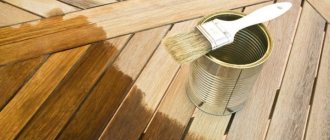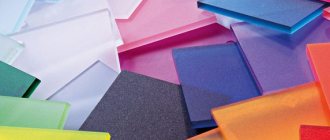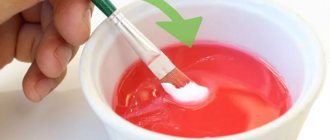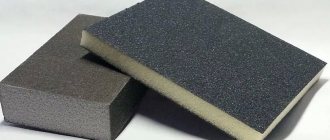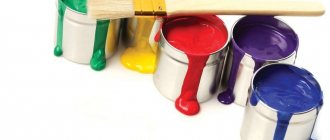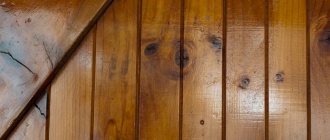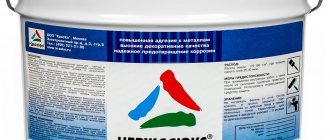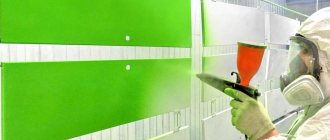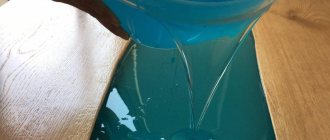In our store we carry out computer tinting of paints and varnishes according to color tables (fans) of various manufacturers. We offer paint tinting services for walls, ceilings, floors, as well as varnish and antiseptics at reasonable prices. Find out the exact price per liter from the managers by phone. +7 (495) 120-09-01 or ask questions by email . In addition, you can contact us through the Feedback .
Attention! Our store provides a free color selection service for computer tinting (on-site at a construction site or at home) according to color catalogs: Tikkurila Symphony Opus 1, Tikkurila Symphony Opus 2, RAL K7, Dulux .
Most often we are asked about the cost of tinting Tikkurila paint, so we provide here a link to the section of the online store where this paint is sold - Tikkurila paints . If you need another paint, you can buy it here . There is a large assortment on sale. On this page we suggest choosing construction varnishes , and on this page - wood preservatives .
If you want to tint paint purchased in another store, call or write, we won’t refuse! The Dominar company is always at your service!
Types of colors by composition
Probably each of you can imagine in theory how the process of giving ordinary white paint the required shade occurs. The main thing in this matter is to choose the appropriate type of color, which is a concentrate of a certain color. Depending on the added amount of this composition, the saturation and intensity of the final paint color will change. By the way, the technology for creating a new shade has two names that imply completely different actions:
- Kolerovka, which we will talk about today is when pigment is added to a white base in order to obtain one of the possible color tones. In this case, the saturation depends on the amount of pigment in the composition;
- Glaze - when two or more colors are mixed to obtain a new, third color. For example, when blue and yellow are mixed to make green. In this case, only the colorants can be mixed first, and then the resulting mixture can be added to the white base to obtain a less saturated tone. It is rational to do this when there was no tint of the desired color, or when there were leftovers of two colors on hand, which, when mixed, give the desired result.
All colors, depending on the origin of the pigments in their composition, can be divided into two types:
- Organic;
- Inorganic.
In the first option, the color will have a more saturated, rich and bright shade, which is undoubtedly an advantage. Their color palette is very wide. However, the finished paint composition based on such a color will have low light fastness, that is, it will fade very quickly in the sun and lose its spectacular original color. In addition, if the paint is applied over mineral-based plaster, which emits a small amount of alkali, this will negatively affect the coating.
Colors
of inorganic origin are more resistant to ultraviolet radiation and retain their original shade for a long time.
But in comparison with organic pigments, the resulting tones will be muted and less concentrated. And the range of possible colors will be more limited. Based on this, many recommend choosing the first type of colorants if artificial lighting will predominate in the room to be painted.
And give preference to the second type of colors if you plan to paint bright rooms filled with natural light throughout almost the entire day.
Advantages and disadvantages of computer tinting
Now there are special machines that allow tinting work to be carried out automatically. The use of these devices has the following advantages:
- Getting rid of the human factor. If by manually selecting the tone you can make a mistake and go too far, which happens quite often, then the robot does not allow such mistakes;
- Selected color parameters can be reused - the final product will be exactly the same;
- A large number of flowers;
- The disadvantage is that it is tied to a specific location and the inability to carry out work directly on site. Moreover, not everyone lives in big cities where such devices are available.
Types of colors by release form
The entire variety of colors can be divided into three large groups depending on the form of their release:
- Powder – are the most affordable. Please note that only water-based paint compositions can be tinted using dry pigment. The palette of possible colors is very limited. Also, powdered dyes are not very convenient to use in terms of calculating the exact dosage. If you don't use special measuring spoons or scales, you will never know how much color you added to the base. Another disadvantage is poor solubility. To obtain a composition that is truly uniform in color throughout the entire depth of the container, you need to mix very thoroughly and for a long time;
- Liquid or color paints – can be sold in tubes, small jars, bottles, plastic buckets or tubes. This paint is very rich and concentrated. With this composition you can safely paint a wall without diluting. This is especially true if you need to achieve the brightest possible shade, for example, when decorating an accent wall. Liquid colorant is more convenient and controllable in dosage. Usually the number of drops is counted. Containers with thin, cone-shaped spouts will be more convenient;
- Pasty ones are the most popular and widespread. The advantage of color pastes is the ability to obtain a soft shade close to natural. They are also quite easy to mix using a whisk and easy to dose.
Color function
Kohler is a well-pigmented base for coloring paint cans. The main function of the color is to add shade to paints that are usually sold in white. You can paint the jar with the base yourself or use a special machine. The first method is applicable to painting when you need to cover a small area. The second method is typical for large industrial scale tinting of cans of dye. The color is sold in several consistencies:
- cans of paint that are smaller in size than standard paints;
- pasty;
- in powder form.
The most pigmented of the above is the first option. Therefore, it is more often found on sale. But you can buy other options.
Tinting paint
Tinting paste
Powdered pigment for paint
Compatibility of colors with various types of paints and other compositions
Many people often have the question of whether it is possible to tint this or that type of paint composition and, if so, which color is best to choose. We decided to clarify this issue:
- If you need to give special shade to a varnish or primer intended for application to wooden surfaces, then you should use color in the form of a paste or color paints;
- For all types of coloring compounds water based There are specialized colors such as “Faidal” or “Colorex”, the packaging of which indicates their compatibility with this type of LKS. Most often these are liquid concentrated pigments;
- For tinting alkyd paints, pastes such as “Interior-Facade”, “Tex”, “Olki”, “Inzsintez”, “Unisistem” will be more suitable;
- It is also permissible to add the above color pastes to whitewash;
- They also produce universal pastes, with which you can tint polyurethane, epoxy, silicone and nitrocellulose enamels. These include “Elast-Color”, “Professional”, “Polymer”, “Unicolor”, “Monicolor”;
- Almost all types of paints can be mixed with colorants with a sheen - pearlescent or metallic.
As you can see, thus, we can safely say that almost all types of paint and varnish compositions and even primers and varnishes can be tinted. In addition, many designers, when creating a coating of decorative plaster, add pigment directly to the composition.
But don’t think that color can be added to the base in unlimited quantities. This is fraught with two unpleasant consequences - the final shade may become too saturated after the paint sits for a while and you will have to either resign yourself and take what you got to work with, or go for a new portion of white paint. Or the coloring composition may lose its adhesive properties and will lie unevenly on the base or slide off.
Follow the basic rules:
- The volume of color added to water-soluble paints should not exceed 20% of their volume;
- For oil paints this figure should not exceed 1.5-2%;
- For all other paint and varnish compositions – no more than 5%.
Then the resulting composition will be suitable for use, and the integration of the pigment will not affect its properties in any way.
Do-it-yourself paint tinting – where to start?
As already mentioned above, the disadvantage of manually tinting paints is that you are unlikely to be able to repeat the desired shade a second time. Therefore, before tinting, carry out a careful calculation in order to find out the exact volume of paint. Each paint has its own consumption; fortunately, manufacturers are required to indicate this data on the packaging. Our task is to find out the area to be painted and multiply the resulting figure by the average paint consumption. Then we add another 10% to the resulting value - in case we exceed the average consumption. It’s better to have spare paint left than to have to guess with the shade.
It is important to do tinting in one container. Even if you accurately calculate the amount of color, there is a possibility that you will get a different shade in two different containers. Therefore, do not take risks, and if the volume is very large and you do not have the necessary vessel, it is better to turn to specialists.
Review of manufacturers
You can often come across the concept of “tinting systems,” which can be misleading with its name. In fact, this is nothing more than the usual palette of possible shades that can be obtained by mixing the base paint and color of a particular manufacturer.
Each manufacturer has the same color, for example, regular red, but it may differ in tone or temperature.
Pay attention to this point. Also, ideally, it is advised to choose the base and color from the same company to ensure a 100% match in color and obtain exactly the shade that is drawn in the palette. It is noteworthy that, despite the fact that using different tints you can get up to 15,000 new interesting shades, tinting systems of different brands have a clearly limited number of possible tones. Let's look at the most popular:
- The well-known one offers consumers its own tinting system called "Tikkurila Symphony". The palette includes no less than 2256 shades, among which you will find about 10 different shades of white. The system involves tinting interior household and general construction paint and varnish compositions. To give the required shade to facade paints, there is a separate system called “Tikkurila Facade”, which includes 232 tones;
- One of the generally accepted tinting systems is the Natural Color System, which is based on the use of six primary colors. Moreover, each color has its own letter designation. Black – S, white – W, yellow – Y, red – R, Green – G, blue – B. All shades obtained based on these colors have their own encoding, consisting of letters and numbers, where the letter indicates the color and the number its percentage in the composition;
- One of the domestic manufacturers of color schemes, whose quality is not inferior to foreign ones, is. The company specializes in the production of tinting paints and pastes compatible with alkyd, oil-based, water-based paints, cement and lime mortars and grouts;
- The line of pigments called “Unicolor” is intended for use with alkyd paints, enamels, varnishes, water-based primers and paints, adhesives and whitewash compositions, oil-based white paints, epoxy and melamine-alkyd compositions;
- Tinting paints "Dali" from Moscow are suitable for use as an independent coloring composition, for water-dispersion paints, plasters, enamels. This line of pigments has increased light fastness, weather resistance, a wide palette of possible shades and high adhesion rates to the base surface.
Methods for tinting LKS
After you have become familiar with the possible types of colors and their compatibility with different compositions, you need to figure out exactly how the paint tinting process itself can be carried out. There are only options :
- By mechanical or automated means;
- Manual.
In the first case, obtaining the required shade occurs on specialized equipment, which is controlled from a computer. Such machines can be found in professional stores that sell exclusively paint and varnish compositions or in large construction markets.
The process goes like this:
- You select the shade you need from the palette or from the color spectrum in the program, which controls the mixing equipment;
- Each shade has a clear composition and strict proportions;
- After this, you need to set the required volume of finished paint;
- Based on these data, the computer makes a calculation and the tinting process itself occurs;
- As a result, you get a guaranteed shade.
This method is undoubtedly very convenient. First of all, if in the end you didn’t guess with the right amount of paint and you simply didn’t have enough, you can always return to the store and make a re-order. This eliminates the difference in shades of the new composition with the previously obtained one.
Although, to be honest, this statement, for me personally, raises some doubts. After all, even the manufacturers of pigments and base paints themselves always warn that the tone of the same color but different batches may differ. This means that the tinted composition will also have differences? Question…
The disadvantages of this method include:
- Additional costs, because this service is not free;
- The impossibility of tinting directly on site and assessing the required shade intensity on site. But this is very important, since a small square of a shade in the palette may be perceived completely differently than the entire wall painted with that color.
Manual tinting is a more painstaking process, but there is nothing complicated about it, and you can do it yourself. This method has only one negative point:
- There is a very high probability that you will not be able to repeat the prepared shade if you do not have enough paint.
But advantages :
- First of all, it's absolutely free;
- Secondly, you can always first prepare a small amount of the composition on the spot, practice, paint a small fragment of the wall with the resulting color and sensibly evaluate the result. And the main thing is to make adjustments in time. And this is exactly what I recommend doing, but more on that a little later;
- And thirdly, you don't need any special equipment. Just a clean, preferably glass container, a wooden stick, a drill and a whisk attachment, a measuring cup and a syringe without a needle.
Benefits of tinting
Even a person who has never held a brush or roller before can handle painting walls and mixing colors. The main thing is to first correct the relief of the walls and prime them. This will eliminate the appearance of unevenness. After this you can do tinting. The main advantage of tinting is the ability to create the shade of color from the palette that is necessary for the room. Even an insignificant difference in shades will turn into a big problem. To avoid this, it is better to try out a new shade on a small area of the wall. This type of painting ennobles the room, more than wallpapering. Tinting is an opportunity to save a little on repairs; many cans with a paint base can be coated with pigment. In addition, the color may not pose a threat to health. Kohler will come to the rescue when you run out of paint of the desired shade, but the supermarket doesn’t have it either. Then you need to create a suitable color.
Pay attention to: Updating suspended ceilings
Step-by-step instruction
The tinting process is not complicated, you just need to adhere to the main rule - do not rush. Many people make the same mistake, which leads to unnecessary additional expenses - they immediately add a large amount of color, and then start mixing the composition. Naturally, in the vast majority of cases, the result will be unpredictable.
We will act carefully and clearly:
- First, let's prepare all the necessary tools that we talked about in the paragraph above;
- Let's prepare a work area for ourselves - cover the floor if it already has a finishing coat, since it is best to dilute the paint in the room for which the shade is being selected;
- We will begin work by preparing a so-called sample, that is, a small amount of tinted paint. At this stage, our task is to decide on the proportions and feel the mixing process itself. After all, the paint must be painted evenly and have a coherent structure;
- To prepare the sample, pour a small amount of white paint into a clean container. Many people don’t write this, but it’s best to use a measuring cup so you don’t have to guess later how much base there was. After this, draw a small amount of color into a syringe without a needle. Add the pigment to the base drop by drop, mix thoroughly and only then, if necessary, add the next drop of dye. You may not notice it by eye, but believe me, with each new drop the shade really changes;
- When, after mixing, the shade is approximately similar to the desired one, stop. The fact is that the prepared composition should be a little lighter than the one you imagined . This is due to the fact that on a large surface, the tone may already be quite saturated;
- Count how many graduations on the scale on the color syringe you used. Write down the volume of the base and color on paper;
- Now you need to do a test staining. This will help you understand whether this is really the shade you need;
- To do this, you don’t need to paint the floor of the wall at all. A small fragment is enough. Literally 40x40 cm. Do not choose a section of the wall in the corner or close to the floor. In such places the shade will always appear darker;
- Color the square at your eye level. And don’t be afraid, if something doesn’t suit you, you can always cover it with the next layer of paint;
- Now we need to evaluate the result. Do not hurry. Look at the square from different angles. Also see how the color looks under different lighting sources. Turn on the overhead light, floor lamp, all together, turn off the light. It is advisable to work in the middle of the day, when there is enough natural light in the room to evaluate the influence of all possible light sources. If time permits, leave the paint on the wall until the next day. In the evening everything may appear completely different;
- If the work is postponed until the next day, close all containers tightly and place them in a dark place;
- Let’s say that the next day the shade is still pleasant to you, then you can safely prepare the working composition. It is very important to dilute the tinting paint with a small margin, just in case;
- When preparing, use the existing proportions. For example, you diluted 5 drops of color in 100 ml of base. This means that for 1 liter of paint you need 50 drops. But this does not mean that you need to add all 50 drops at once. Add 45, mix thoroughly with a whisk, look, add 3 more drops, mix, and only then add the rest of the color and mix again.
As you can see, nothing complicated, just a little patience and diligence.
Features of tinting different types of paints and varnishes
So, how to tint paint at home? The process is divided into the following stages:
- Prepare a couple of plastic containers.
- Measure out 0.1 liter of base color and pour into 1 container.
- Add a little dye to the base composition, and if a more complex color is required, you can combine different colors at the same time.
- Write down the amount of base used (0.1 liter), how many drops of color were added and describe the result of mixing.
- The color and base need to be mixed until you get a uniform tone.
- If the color appears pale, add brightness by adding drops at a time.
- As soon as you get the desired color, you should paint a small part of the surface and after drying, evaluate the result in artificial and daylight. It is worth considering that the color on the base paint will look brighter than in the container.
- If the test mixing was successful, then you can tint the rest of the paint - calculate the required amount of pigment, and then subtract 20% from the result obtained so that the final shade matches the test one (on a large area the color will look brighter than on a small one).
Small tips
Some important points that should be taken into account when tinting yourself:
- It is recommended to choose paint and colors from the same manufacturer for a reason; adhere to this recommendation;
- An interesting fact is that in fact, the amount of binder in the base paint is responsible for the possible intensity during tinting. The more it is, the richer and darker the shade you can get. Therefore, when choosing paint, you definitely need to pay attention to this;
- Most often, white paint is used as the base paint. And not just white, but snow-white. If it is difficult for you to determine the degree of whiteness by eye, use a simple test. Place a piece of paper next to an open can of paint or the corresponding white color in your palette. If the paint is darker, yellower, or grayer, it does not suit. Only whiter, or the same shade. Otherwise, when mixing, the yellow or gray tint of the base may affect the final result. And instead of, for example, purple, you get dirty pink;
- When you evaluate the result of a test stain under different lighting, it is advisable that the light source be exactly the one that will be used in the future in this room;
- The color applied to the wall will always seem more saturated than on the sample. And in the corners it will appear darker, this is normal;
- If you have not used the entire volume of the color, you can dilute it in a small amount of water, twist it tightly and place it in a dark place. In this form, pigments can be stored for up to 5 years;
Types of tinting pigments
There are several types of tinting pigments on sale. Let's look at the most popular options.
- Water-soluble pigments. Used for adding to paints and varnishes that are made on a water base. In most cases, only light paint colors will work. A huge advantage of the material is that the finished paint will withstand ultraviolet radiation well.
- Based on organic solvents. Such pigments are usually used to change the color of mixtures that contain resins and oils. As a result, it is possible to obtain paints of very bright and rich colors. The downside is that over time the pigment may begin to fade. In addition, the finished material does not tolerate exposure to alkalis.
- Universal. This type of color can include special pastes. They are characterized by slow burnout and can provide, after mixing, varying degrees of brightness of the paint and varnish material. Suitable for mixing with a wide variety of paints.
The choice of products of this type is quite large, so it will not be difficult to choose the desired pigment and its shade.
